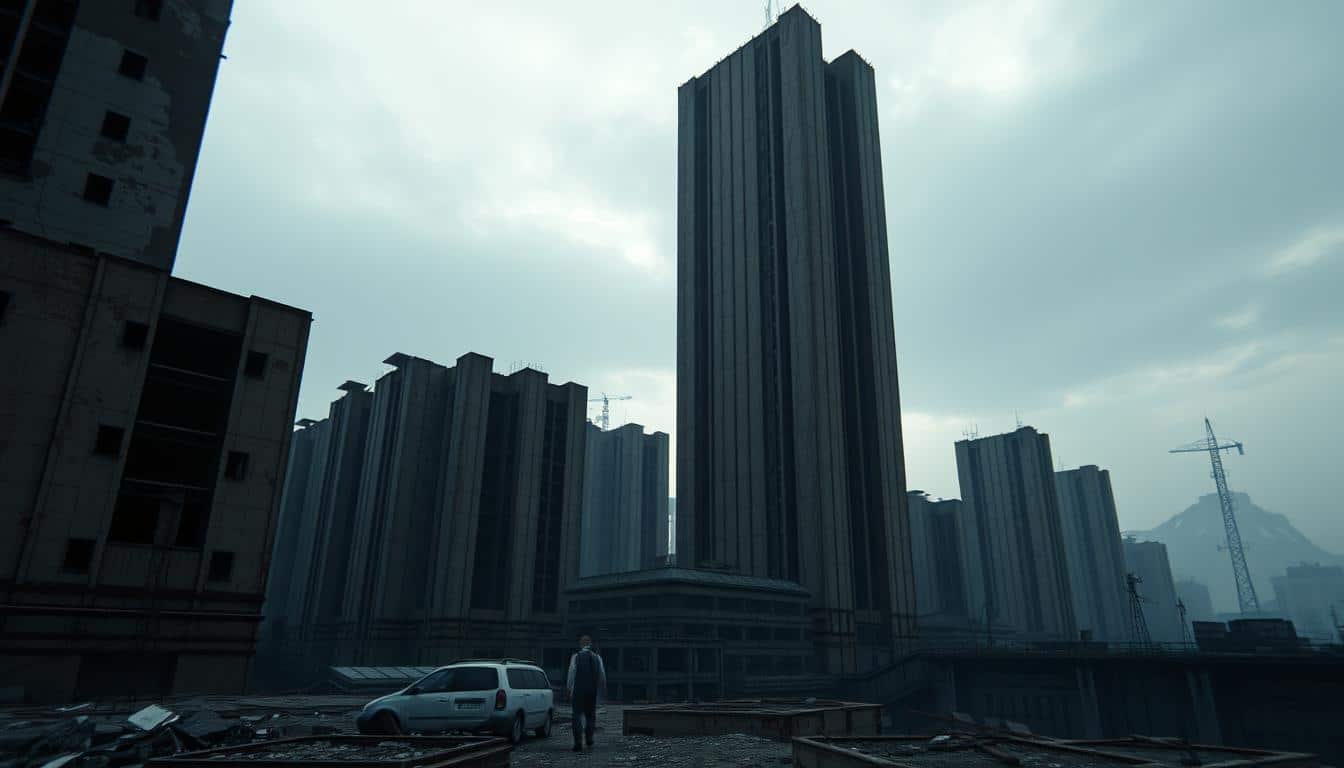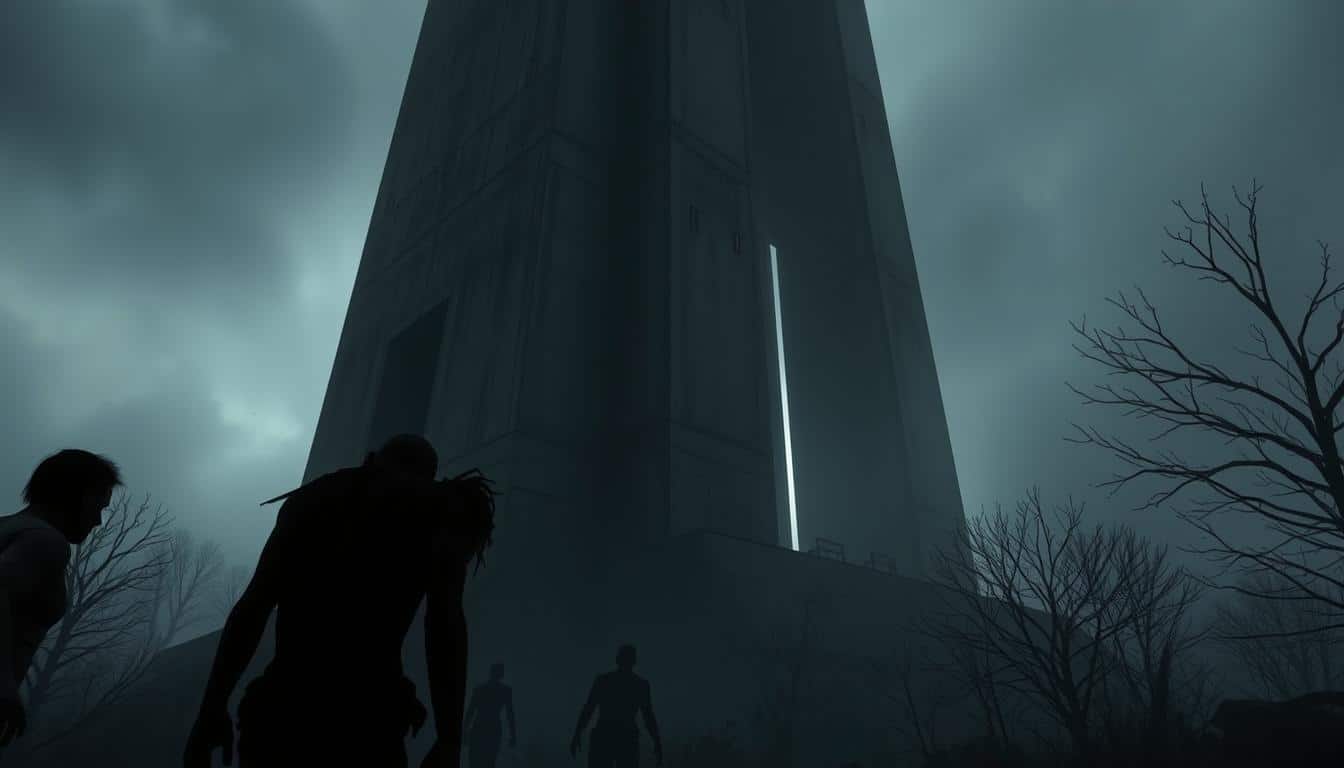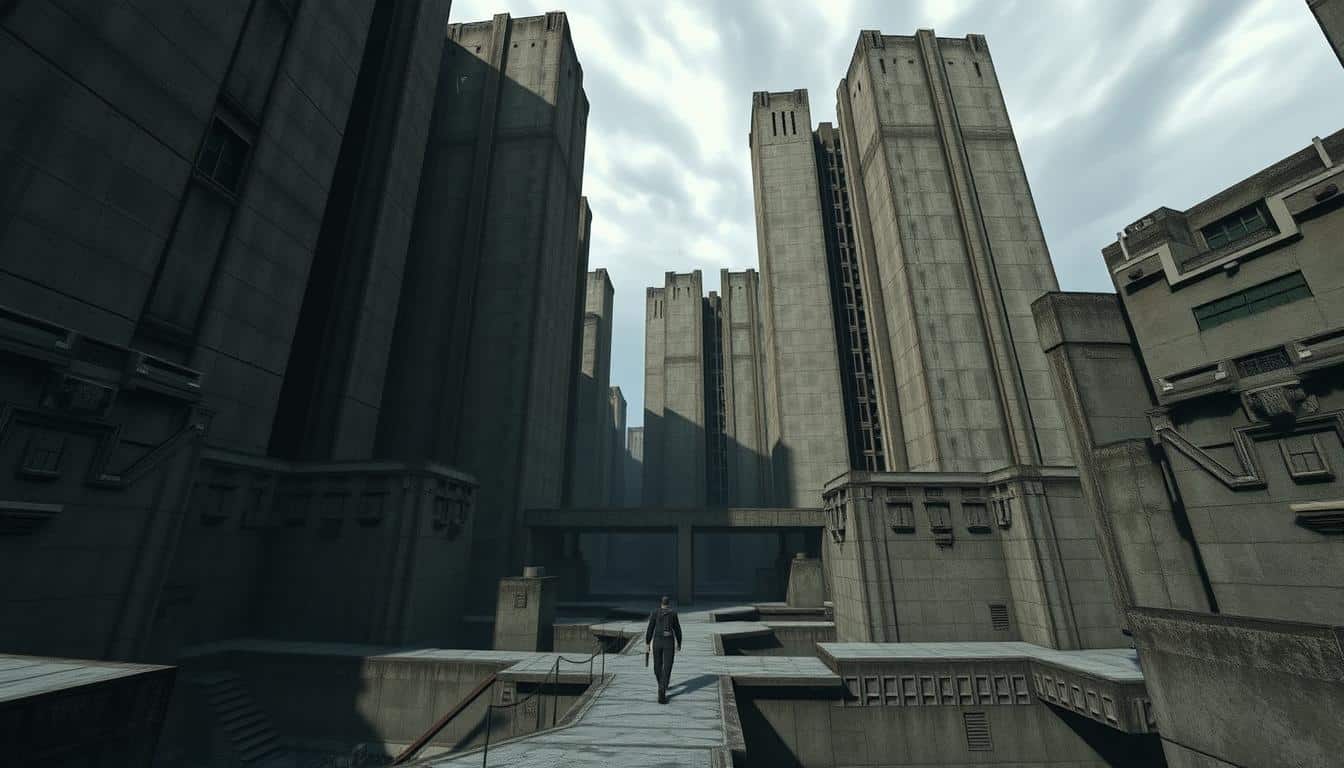Soviet brutalism and video game design together are capturing imaginations. They show how brutalist architecture can improve gameplay and make it deep. Game designers use the strong looks of Soviet buildings to create exciting worlds. These worlds make players feel deep emotions and think about history.
This style’s raw power inspires game creators. It brings new ideas to game design by making the play area more engaging. It also makes us think about themes like being alone and future worlds, which are big in games today.
The Origins of Soviet Brutalism
Soviet brutalism’s roots are deeply tied to the wider story of Soviet architecture history. It began in the early 20th century, showing the social and political shifts of the Soviet Union’s birth. Through different national movements, it linked artistic endeavor with ideological beliefs.
Historical Context of Soviet Architecture
Soviet architecture morphed dramatically, guided by socialist realism ideals. This aim was to mirror the working class’s hopes and display communism’s value. Architects of the time aimed to make buildings that were practical yet showcased the USSR’s strong design ethos.
Key Features of Brutalist Design
Brutalism stands out for its:
- Raw concrete facades that emphasize strength and durability
- Bold geometric shapes creating a sense of modernity
- A lack of ornamentation, reflecting starkness and functionality
The style’s core traits echo socialist realism’s goals, by illustrating the era’s intent with bold, commanding forms. As years pass, the enduring brutalist buildings serve as cultural symbols. They keep telling the tale of Soviet architecture to new generations.

The Aesthetic Appeal of Brutalism in Gaming
Brutalist aesthetics in games show through unique visual elements that touch players deeply. This style is marked by simple, stark designs and minimalistic architecture, bringing brutalism’s essence to gaming visuals. It leads to an emotional response from players, pulling them into worlds that feel isolated and oppressive.
Visual Elements That Capture the Brutalist Style
Harsh lighting, raw materials, and bold shapes are key to the brutalist look in video games. These features make the game’s world feel real and bleak, wrapping players in the setting. Games that use the simplicity of concrete and plain structures highlight intense stories.
Emotional Impact on Players
Brutalist environments in games make players’ feelings more intense. The visuals stir up strong emotions linked to history and culture, adding depth to the game’s story. Developers use this style to make the gameplay more engaging and spotlight important game themes.
Soviet Brutalism Inspiration for Game Design
Soviet brutalism inspires game designers with its unique features. They use brutalist architecture to make game environments feel real. This style’s function and look help tell stories and keep players involved.
How Architecture Influences Game Environments
Game designers use architecture to make better gameplay. Brutalist buildings’ straight lines and big shapes become lively virtual spaces. These spaces help players understand the game’s story better.
They encourage players to explore and become part of the story. This makes the game more engaging and fun.
The Role of Functional Brutalist Structures
Many games are built around functional structures. These don’t just serve a purpose; they help tell the game’s story. By using brutalism, game makers create places that fit the game’s theme.
These spaces make players feel more connected to the game’s world. The mix of form and function makes the game more immersive. It makes players feel like they are really there.
Iconic Video Games Embracing Brutalist Design
Brutalist design is big in video games, making worlds that are deep and complex. Games like Papers, Please and the Metro series skillfully blend brutalism into their stories and looks. These titles show that architecture can make game experiences that pull players in and challenge them.
Spotlight on Papers, Please
Papers, Please is a top example of brutalist video games. It mimics the stark, Soviet-era architecture’s feel. Players work at a border, facing tough choices as they follow or break the rules. The game’s look is simple but strong, making players feel trapped and full of tough choices. This style grabs players, putting them in a tense, choice-driven world.
The Architecture in Metro Series
In the Metro series, brutalist themes are a standout. It’s set after the world ends, with scenes in old subway tunnels and stations that look like Soviet buildings. The game shows off ruins and the will to keep going, much like brutalist buildings. As players move through these spaces, they dive into stories of hard times and hope. This makes the game’s story even more moving.
Game Titles Influenced by Soviet Aesthetics
Games inspired by the Soviet Union have made a big impact on the gaming world. They offer stories and settings that really draw in players. The Command & Conquer series and the Tropico games are perfect examples. They mix Soviet design and stories, showing how game makers use history to make games more engrossing.
Examples from Command & Conquer Red Alert
The Command & Conquer games, especially Red Alert, mix alternative history with Cold War themes. The game’s look includes Soviet military tech and propaganda. Players get into strategic battles, using units and buildings styled after Soviet icons. This grand view of Soviet themes makes the game’s world more engaging and fun.
Impact of Tropico Series on Game Design
The Tropico series shows how Soviet influences can shape game making today. It uses Soviet-style buildings and political jokes. Players act as dictators, trying to manage the economy and keep people happy. The game’s buildings remind you of Soviet times, but in a funny way. It mixes this humor with deep stories and gaming challenges, using Soviet inspirations to enrich the experience.
Creating Immersive Experiences through Architectural Inspiration
In immersive game design, how spaces are designed is key to player engagement. The indie game It’s Winter uses post-Soviet architectural styles to draw players in. Its detailed settings make even the most everyday spaces fascinating, deepening the gaming experience.
Detailed Environments in It’s Winter
It’s Winter captures its scene with carefully crafted locations. These are not just backdrops but characters that affect the player’s experience. Faded colors and old buildings create a unique atmosphere. This atmosphere is both eerie and beautiful, drawing players deeper into the game world.
The Role of Emotionally Charged Spaces
Emotional spaces in It’s Winter strike a chord with players. The game blends architecture into its story, creating a deep emotional bond. Players feel loneliness and nostalgia, making the story more engaging. This mix of style and story shows the power of design in game storytelling. It shows how spaces can turn feelings into a part of the game experience.
The Evolution of Game Design with Brutalist Influences
The world of game design is always changing, with new artistic movements shaping it. One major influence is from indie games and brutalism. This approach is changing game environments, giving players new experiences that connect on many levels.
Trends in Indie Games and Brutalism
Indie games often draw on brutalism’s unique look, featuring stark designs and raw concrete. Titles like “Superliminal” and “The Beginner’s Guide” use simple shapes and minimalist settings. This reflects architectural ideas in video games. These styles make for immersive worlds that encourage players to explore and think deeply. By stepping away from usual game looks, these games deepen how players feel while playing. This movement is about simplicity and effectiveness, inspiring indie creators to explore new ways of telling stories visually.
The Future of Game Environments with Architectural Themes
The gaming world keeps evolving, and using architectural themes is becoming more common. Future games might focus more on the structure of spaces. These spaces will be more than just backdrops; they’ll help tell the story. Gamers could find themselves in settings that highlight brutalist themes. This would make the game more immersive and help convey its message better. The close link between design and storytelling shows how important architecture is in making deep, engaging game experiences.
Reasons Why Developers are Turned to Brutalism
Developers are increasingly drawn to brutalism. They find it a cool way to bring unique architectural styles into game design. This shift opens up new ways for telling stories through buildings. It helps make games more engaging for players. Brutalism’s bold qualities match well with modern game themes. They create spaces that are visually stunning and full of emotion.
Unique Visual Storytelling Potential
Developers love brutalism for its strong visual storytelling. Its sharp lines and bare materials set the stage for many stories. This lets players connect deeply with the game world, seeing buildings as part of the story. Each architectural piece can tell its own tale, encouraging players to dig deep and discover hidden meanings.
Emphasizing Themes of Isolation and Dystopia
Brutalism is great for highlighting isolation and dystopia themes, reflecting our fears and personal stories. Its bold look echoes the loneliness seen in future-based stories. Developers use these feelings to make game worlds that deeply move players. This kind of storytelling makes games more intense and thought-provoking. It makes players think about the game and real-life problems too.
A Cultural Commentary Through Game Design
Video games inspired by Soviet brutalism offer more than just fun. They are a strong medium for cultural statements in the gaming world. These games throw light on historical suffering. They explore serious topics that touch our society deeply.
Developers blend social concerns with game mechanics. This approach lifts games to the level of modern art.
Reflections of Historical Oppression in Gameplay
Many games draw on brutalist architecture to highlight repression and hardship. This design reflects real past sufferings. It allows players to feel complex emotions.
The stark settings make players think about big societal problems. They navigate through eerie virtual worlds.
Games as Contemporary Art Forms
Games prove they are serious art through creativity. They mix cultural insights with historical stories. This mix educates players on social issues.
Games make people reflect on their own lives while exploring dark and minimalist designs. This confirms games’ place as art.
Conclusion
The journey into Soviet brutalism in game design combines unique architecture and interactive storytelling. It captures the stark, imposing traits of brutalist design. This lets game creators bring players deeper into the game while touching on isolation and dystopia themes.
This look at Soviet brutalism shows how it has deeply influenced game design. It sparks creativity that focuses on looks and deep stories.
As games evolve, these architectural styles will keep influencing game looks. This trend shows how important architecture is in making games more engaging. It makes games better by adding rich environments and emotional spaces.
The role of Soviet brutalism in game design is huge in engaging players. It helps the industry find new, creative ways to entertain and make players think. It prepares the stage for a thrilling future in game looks.



